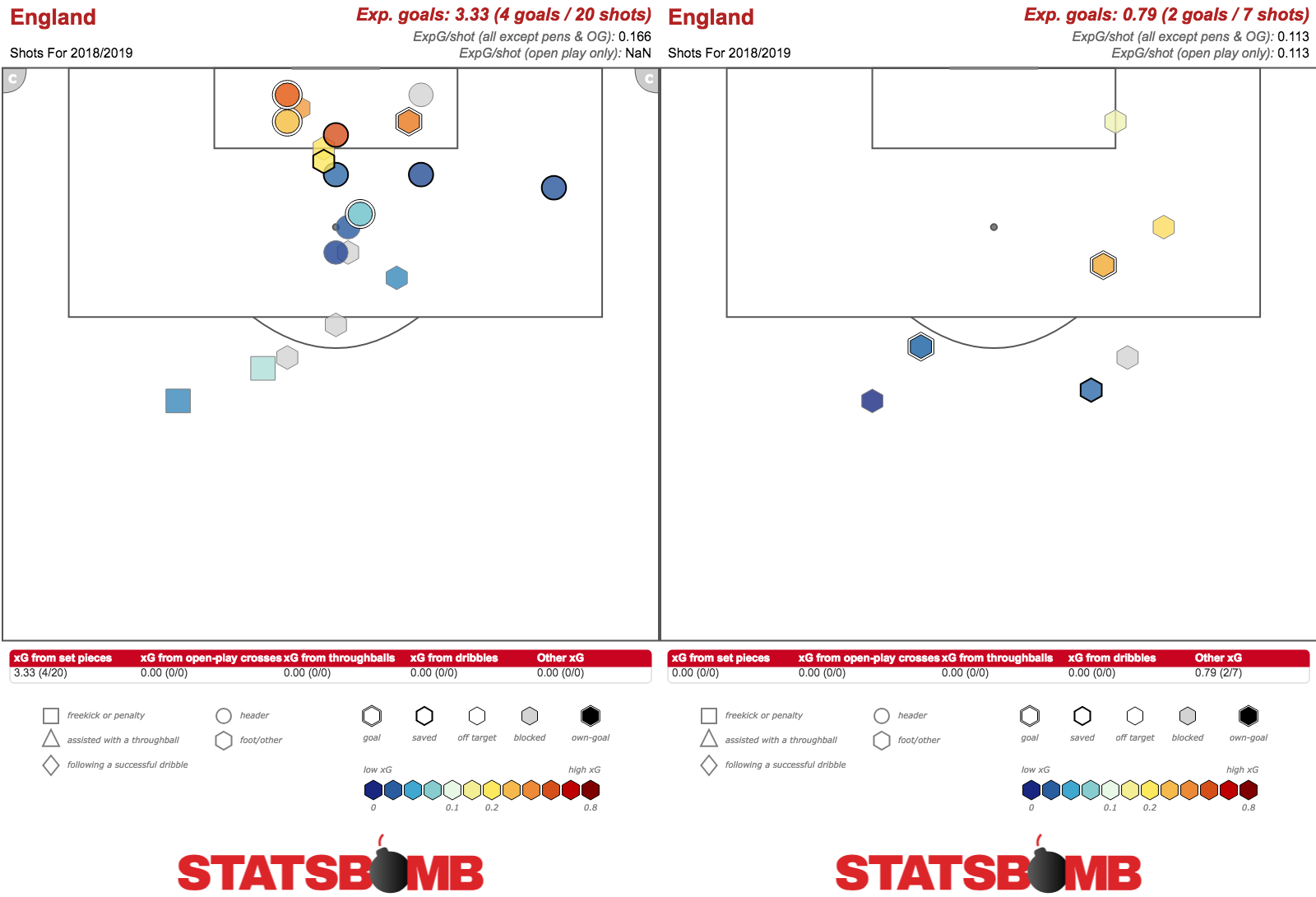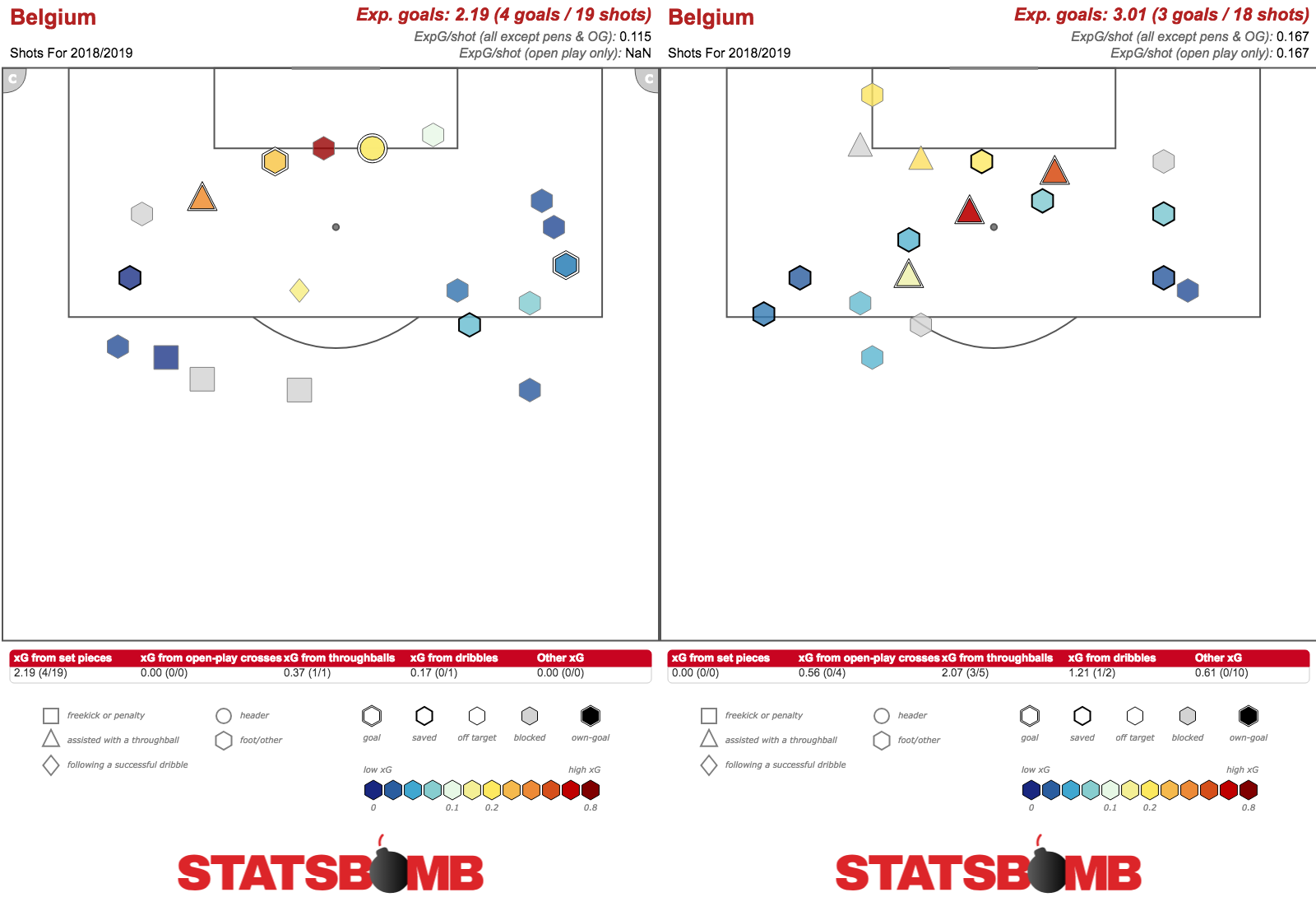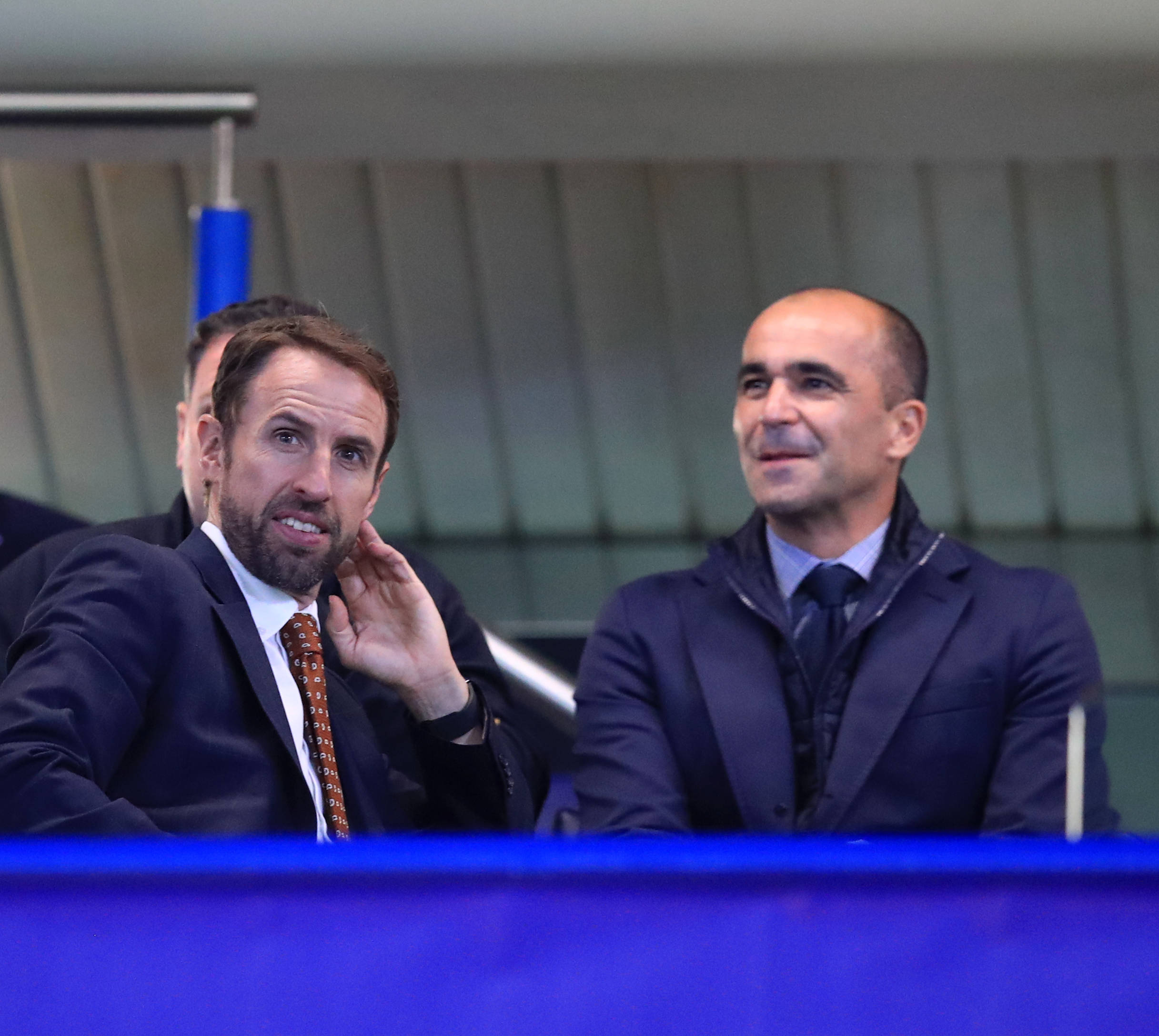We’ve reached the showpiece game of Group G, the one that everyone picked out when the draw was made back in December. It also might be a non-event. With both England and Belgium having already qualified for the knockout stages, there have been questions of how seriously each side should take it, with some even advocating a deliberate attempt to lose in order to slip into the easier side of the bracket. Germany’s exit from the competition complicates things on this front somewhat, but there’s still a case to be made for finishing second. On the Belgian side, manager Roberto Martinez has said that “there will be major changes against England”, and while England manager Gareth Southgate insists that “we want to win every game”, it has been widely reported in the country’s press that there will be a number of alterations to the lineup. England for their part have been largely comfortable throughout the first two games, generating 2.06 expected goals per game and only conceding 0.72. The team has stuck to the 3-5-2 system it tried before the tournament, and generally hasn’t shown frailties. The only concern would be the second half against Tunisia, in which the North African side switched to a similar formation frustrated England’s build up play. Due to the lack of creative passers in the England squad, the side is very reliant on the structure of the system, so there isn’t much to do if it fails. This is particularly noteworthy as Belgium themselves employ a 3-4-3 system with the potential to frustrate England’s structure. That would require Belgium to be well organised, though, and there hasn’t been much evidence of tactical discipline from them. A lot has been said about England’s proficiency from set pieces, attempting various clearly pre-planned routines and scoring from many of them. There is evidence, though, that the effectiveness of this might be hiding a lack of quality in open play. In the game against Panama, England only managed to register a single shot in the box from open play, a largely fortuitous Ruben Loftus-Cheek attempt from range which deflected off an unaware Harry Kane. This can be seen quite clearly in the two shot maps below. The image on the left is all the xG England have so far generated from set pieces, while on the right we can see the much less impressive xG from open play.  One potential reason not to get too worried about this is that England were facing two sides in Tunisia and Panama that defend with a very deep block. England’s attacking players are generally more comfortable running into space and receiving the ball than progressing it themselves, so it’s possible that a higher pressing side will allow them to create more on the break. And while there have been concerns about defensive concentration lapses in the tournament so far, England did look solid in the past year in friendlies against better sides Germany and Brazil. This is entirely hypothetical for the time being, but there is at least some reason to think that this team should be able to perform against the better sides in the competition. In terms of the changes that are likely to occur for this game, Fabian Delph may be a wise inclusion. It seems likely that Eric Dier will come in for Jordan Henderson, and while there are areas in his game in which he is superior to the Liverpool captain, mobility is not one of them. Delph’s energy should be able to make up for the loss of Henderson in this regard. Furthermore, his positioning is naturally more conservative than the other players who have played the central midfield role so far, which may at times mean England form more of a double pivot with Delph and Dier. As Belgium’s 3-4-3 system employs two attacking midfielders (usually Hazard and Mertens, though they may be rested), a slight midfield tweak could help nullify their effectiveness. In terms of what Belgium might offer in this game, the number of expected changes clouds any predictions of how effective they might be. With their strongest eleven, they have been utterly dominant so far, with their 2.6 expected goals per game the strongest of any side in the tournament, and an expected goal difference per game of 1.57 matched only by Spain. Unlike England, this has been nicely balanced between set pieces and open play, showing a variety of options to break sides down. (As before, the image on the left shows xG from set pieces, while the map on the right shows xG from open play).
One potential reason not to get too worried about this is that England were facing two sides in Tunisia and Panama that defend with a very deep block. England’s attacking players are generally more comfortable running into space and receiving the ball than progressing it themselves, so it’s possible that a higher pressing side will allow them to create more on the break. And while there have been concerns about defensive concentration lapses in the tournament so far, England did look solid in the past year in friendlies against better sides Germany and Brazil. This is entirely hypothetical for the time being, but there is at least some reason to think that this team should be able to perform against the better sides in the competition. In terms of the changes that are likely to occur for this game, Fabian Delph may be a wise inclusion. It seems likely that Eric Dier will come in for Jordan Henderson, and while there are areas in his game in which he is superior to the Liverpool captain, mobility is not one of them. Delph’s energy should be able to make up for the loss of Henderson in this regard. Furthermore, his positioning is naturally more conservative than the other players who have played the central midfield role so far, which may at times mean England form more of a double pivot with Delph and Dier. As Belgium’s 3-4-3 system employs two attacking midfielders (usually Hazard and Mertens, though they may be rested), a slight midfield tweak could help nullify their effectiveness. In terms of what Belgium might offer in this game, the number of expected changes clouds any predictions of how effective they might be. With their strongest eleven, they have been utterly dominant so far, with their 2.6 expected goals per game the strongest of any side in the tournament, and an expected goal difference per game of 1.57 matched only by Spain. Unlike England, this has been nicely balanced between set pieces and open play, showing a variety of options to break sides down. (As before, the image on the left shows xG from set pieces, while the map on the right shows xG from open play).  There remains a sense, though, that this success is built almost entirely on the back of individual talent. In the opening game for example, they were only able to generate 0.66 expected goals in the first half against a very unimpressive Panama, before Dries Mertens’ brilliant 46th minute strike changed the course of the game. The 3-4-3 system that Roberto Martinez has favoured seemed designed to be able to use all of Toby Alderweireld, Vincent Kompany and Jan Vertonghen in the same side, but Kompany has so far been injured and Belgium have instead used Dedryck Boyata at the heart of the defence. With the back three then necessitating direct winger Yannick Ferreira Carrasco at left wing back, and attacking playmaker Kevin De Bruyne sitting deep in a double pivot, it’s not clear who is benefitting from this shape. Furthermore, there’s evidence that the players are either struggling to understand the defensive responsibilities of the system, or just uninterested in doing the required work. The central midfielders have been seen far out of position, for example, which hasn’t caused huge issues so far but could easily be exposed by a side such as England that can cause problems on the counter. This could be caused by a lack of effort and discipline. Alternatively, it could be that asking Kevin De Bruyne, typically fairly advanced as a “free eight” in Manchester City’s midfield three, to hold a disciplined midfield position he has never been seen in at club level isn’t a recipe for success. None of this is very surprising considering the identity of the manager. In Roberto Martinez’s time in the Premier League, his Wigan and Everton sides went about attempting an admirably expansive game plan to often less than ideal results. One of his central ideas was to move more creative players into deeper roles, presumably to improve the side’s passing from deep areas, and this seems to be behind the De Bruyne switch. The problem with this is a lack of time. At club level, he at least had time to coach the players into what he wanted from them, even if it seemed like the coaching wasn’t hugely effective. Here, De Bruyne is essentially being thrown straight into a new position and being asked to make it work. If the Manchester City man starts in this game, it might be worthwhile to experiment in moving him into the forward line, in the role he played earlier in his career. This would allow someone more accomplished in the tactical challenge of playing central midfield, such as Mousa Dembele or Youri Tielemans, to give the side a better balance that will likely be needed in the knockout stages. Granted, all of this stuff is on the margins, and it’s hard to look past the Belgians’ dominance over the first two games. This team remains absolutely crammed full of talent, and they should be able to cause problems for any team in the knockout stages. In some ways they find themselves in the opposite position to England, with a number of great creative passers and dribblers that can easily break down teams with their individual quality, but little in the way of cohesion. With the identity of the two teams, it seems likely that Belgium will dominate possession in Kaliningrad. England’s better organisation could have the potential to keep the possession in largely ineffective areas, however, and this could be the kind of game in which the centre backs end up passing to each other a lot. With neither side needing to win, this might not bother either country too much, and unfortunately a fairly dull game could be in order. Header Image Courtesy of the Press Association
There remains a sense, though, that this success is built almost entirely on the back of individual talent. In the opening game for example, they were only able to generate 0.66 expected goals in the first half against a very unimpressive Panama, before Dries Mertens’ brilliant 46th minute strike changed the course of the game. The 3-4-3 system that Roberto Martinez has favoured seemed designed to be able to use all of Toby Alderweireld, Vincent Kompany and Jan Vertonghen in the same side, but Kompany has so far been injured and Belgium have instead used Dedryck Boyata at the heart of the defence. With the back three then necessitating direct winger Yannick Ferreira Carrasco at left wing back, and attacking playmaker Kevin De Bruyne sitting deep in a double pivot, it’s not clear who is benefitting from this shape. Furthermore, there’s evidence that the players are either struggling to understand the defensive responsibilities of the system, or just uninterested in doing the required work. The central midfielders have been seen far out of position, for example, which hasn’t caused huge issues so far but could easily be exposed by a side such as England that can cause problems on the counter. This could be caused by a lack of effort and discipline. Alternatively, it could be that asking Kevin De Bruyne, typically fairly advanced as a “free eight” in Manchester City’s midfield three, to hold a disciplined midfield position he has never been seen in at club level isn’t a recipe for success. None of this is very surprising considering the identity of the manager. In Roberto Martinez’s time in the Premier League, his Wigan and Everton sides went about attempting an admirably expansive game plan to often less than ideal results. One of his central ideas was to move more creative players into deeper roles, presumably to improve the side’s passing from deep areas, and this seems to be behind the De Bruyne switch. The problem with this is a lack of time. At club level, he at least had time to coach the players into what he wanted from them, even if it seemed like the coaching wasn’t hugely effective. Here, De Bruyne is essentially being thrown straight into a new position and being asked to make it work. If the Manchester City man starts in this game, it might be worthwhile to experiment in moving him into the forward line, in the role he played earlier in his career. This would allow someone more accomplished in the tactical challenge of playing central midfield, such as Mousa Dembele or Youri Tielemans, to give the side a better balance that will likely be needed in the knockout stages. Granted, all of this stuff is on the margins, and it’s hard to look past the Belgians’ dominance over the first two games. This team remains absolutely crammed full of talent, and they should be able to cause problems for any team in the knockout stages. In some ways they find themselves in the opposite position to England, with a number of great creative passers and dribblers that can easily break down teams with their individual quality, but little in the way of cohesion. With the identity of the two teams, it seems likely that Belgium will dominate possession in Kaliningrad. England’s better organisation could have the potential to keep the possession in largely ineffective areas, however, and this could be the kind of game in which the centre backs end up passing to each other a lot. With neither side needing to win, this might not bother either country too much, and unfortunately a fairly dull game could be in order. Header Image Courtesy of the Press Association
2018
England vs Belgium: Preview of a Deadish Rubber
By admin
|
June 28, 2018
